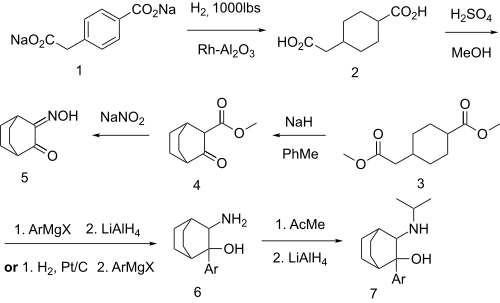 | |
| Clinical data | |
|---|---|
| ATC code |
|
| Identifiers | |
| |
| CAS Number | |
| PubChem CID | |
| ChemSpider | |
| UNII | |
| ChEMBL | |
| Chemical and physical data | |
| Formula | C17H23Cl2NO |
| Molar mass | 328.28 g·mol−1 |
| 3D model (JSmol) | |
| |
Cilobamine is a drug which acts as a norepinephrine-dopamine reuptake inhibitor (NDRI) and has stimulant and antidepressant effects.[1][2]
It can clearly be seen that the structure is based on dichloroisoprenaline that has been fused onto the bicycloalkane scaffold.
Synthesis[edit]

An intramolecular Dieckmann cyclization on methyl 4-(2-methoxy-2-oxoethyl)cyclohexanecarboxylate [1401222-79-4] (3) with sodium hydride base gives reaction Methyl 3-oxobicyclo[2.2.2]octane-2-carboxylate [30144-30-0] (4). Treatment with sodium nitrite introduces an isonitroso group adjacent to the ketone, giving 3-Hydroxyiminobicyclo[2.2.2]octan-2-one, CID:131066320 (5). Addition of the aryl Grignard reagent, and reduction of the oxime gives CID:154108204 (6). A reductive amination of the primary amino group with acetone then completed the synthesis of cilobamine (7).
See also[edit]
References[edit]
- ^ Leeson GA, Shaath ZA, Biedenbach SA, Yarrington JT, Okerholm RA (April 1984). "Dose related induction of the drug metabolizing enzymes of rat liver by cilobamine". Fundamental and Applied Toxicology. 4 (2 Pt 1): 261–9. doi:10.1016/0272-0590(84)90127-1. PMID 6724198.
- ^ Wager S, Quitkin F, Stewart J, McGrath P, Harrison W, Markowitz J, Tricamo E (1988). "Cilobamine in the treatment of atypical depression". Human Psychopharmacology: Clinical and Experimental. 3 (3): 201–205. doi:10.1002/hup.470030308. S2CID 145253439.
- ^ DE2003744 idem Jules Freedman, U.S. patent 3,651,142 (1970 to Colgate Palmolive Co).
| |||||||||||||||||||||
| |||||||||||||||||||||
| |||||||||||||||||||||
| |||||||||||||||||||||
| |||||||||||||||||||||
| D1-like |
| ||||||
|---|---|---|---|---|---|---|---|
| D2-like |
| ||||||
Well, that’s interesting to know that Psilotum nudum are known as whisk ferns. Psilotum nudum is the commoner species of the two. While the P. flaccidum is a rare species and is found in the tropical islands. Both the species are usually epiphytic in habit and grow upon tree ferns. These species may also be terrestrial and grow in humus or in the crevices of the rocks.
View the detailed Guide of Psilotum nudum: Detailed Study Of Psilotum Nudum (Whisk Fern), Classification, Anatomy, Reproduction